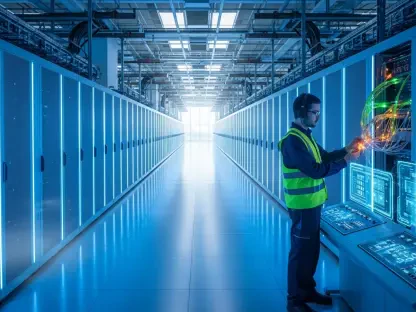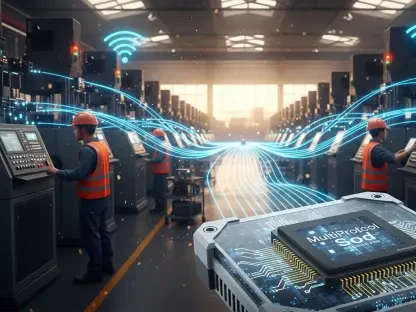What happens when an industry pours a staggering $380 billion into reshaping the backbone of the digital world? This colossal investment in AI-driven data center infrastructure signals a monumental shift, one that is redefining how technology powers everything from everyday apps to cutting-edge innovation. As AI continues to dominate technological advancements, data centers are no longer just storage hubs—they are evolving into the epicenter of a new era, grappling with unprecedented demands and opportunities.
This massive financial commitment isn’t just about building more facilities; it’s about revolutionizing the way data centers operate to keep pace with AI’s insatiable needs. With computational requirements soaring and sustainability pressures mounting, the stakes have never been higher. This transformation touches every corner of society, from the seamless streaming of content to the development of life-changing medical research, making it a story worth exploring in depth.
Why a $380 Billion Investment in AI Data Centers Changes Everything
The sheer scale of a $380 billion bet on AI infrastructure underscores a pivotal moment for technology. This isn’t merely a cash infusion—it represents a fundamental reimagining of data centers as the critical foundation for AI’s explosive growth. Industry leaders view this as a necessary step to ensure that the digital ecosystem can support the next wave of innovation, from autonomous systems to real-time analytics.
Beyond the numbers, this investment highlights a pressing reality: data centers must evolve rapidly to remain relevant. The urgency stems from AI’s ability to process vast datasets at lightning speed, pushing traditional infrastructure to its limits. Operators are now tasked with not only expanding capacity but also rethinking how these facilities function in a world increasingly dependent on intelligent systems.
This financial surge also reflects confidence in AI’s long-term impact on global economies. Stakeholders across sectors recognize that without robust, AI-ready data centers, progress in fields like healthcare, finance, and transportation could stall. The magnitude of this commitment sets the stage for a transformative journey, one that promises to redefine technological boundaries.
The Urgent Need: Data Centers Adapting to AI’s Relentless Demands
As AI applications multiply, data centers face intense pressure to scale and innovate. No longer just repositories of information, these facilities are becoming the nerve centers for complex algorithms that power everything from voice assistants to predictive models. The challenge lies in meeting computational demands that grow exponentially, often outpacing current capabilities.
Traditional setups are proving inadequate for the unique requirements of AI workloads, which demand high-speed processing and massive energy inputs. Many older data centers struggle with inefficiencies, unable to handle the heat and power needs of advanced hardware. This gap has prompted a critical reassessment of infrastructure design, pushing for solutions that can sustain AI’s rapid evolution.
The societal implications are vast, as delays or failures in data center performance could disrupt essential services. From enabling real-time traffic updates to supporting groundbreaking scientific discoveries, the reliability of these systems is paramount. This investment wave marks a turning point, compelling the industry to prioritize resilience and adaptability in equal measure.
Key Drivers of Change: Testing, Efficiency, and Networking in Focus
AI’s influence on data centers hinges on three critical areas of transformation. First, testing has shifted from theoretical models to production-grade simulations that mirror real-world AI workloads. This method allows operators to identify weaknesses before deployment, ensuring systems can endure the intense demands of live environments without faltering.
Energy efficiency stands as another pressing concern, with projections estimating AI infrastructure could account for 12% of U.S. electricity consumption by 2027. Strategies like real-time monitoring and digital twins—virtual replicas of physical systems—help optimize power usage while maintaining peak performance. These tools enable dynamic adjustments, cutting waste and addressing the growing call for sustainability in tech operations.
Networking, the third pillar, is undergoing a revolution with innovations like 1.6T Ethernet and Ultra Ethernet gaining traction. A recent survey indicated that 22% of operators are already testing these high-speed solutions to eliminate data flow bottlenecks. Enhanced telemetry and analytics further support this shift, offering predictive insights to keep networks agile and efficient amidst AI’s complex demands.
Expert Perspectives: Navigating the AI Data Center Landscape
Insights from industry leaders paint a vivid picture of the challenges and aspirations driving this transformation. A comprehensive survey revealed a strong push toward next-generation networking, with many operators prioritizing speed and scalability as non-negotiable for AI integration. This proactive stance underscores a collective understanding of the need to stay ahead of technological curves.
Sustainability emerges as a recurring theme among experts, who stress that innovation must align with environmental responsibility. Many in the field advocate for energy-efficient designs as a core component of future infrastructure, citing the dual benefits of cost savings and reduced carbon footprints. This balance between progress and stewardship resonates as a guiding principle for the sector.
Frontline operators also highlight the complexity of managing AI-driven facilities, often describing the steep learning curve involved. Their experiences emphasize the importance of collaboration across disciplines to tackle issues like overheating hardware and data latency. These voices collectively affirm that the path forward requires both bold investment and thoughtful strategy to succeed.
Practical Steps: Crafting Smarter Data Centers for AI’s Future
Navigating the AI revolution demands actionable strategies tailored to data center challenges. Implementing production-grade simulations offers a proactive way to test infrastructure under realistic conditions, minimizing the risk of failures during critical operations. This approach empowers teams to refine systems before they face the full brunt of AI workloads.
Dynamic resource management provides another vital tool, optimizing energy consumption by shifting non-urgent tasks to off-peak hours. Coupled with real-time monitoring, this tactic ensures resources are allocated efficiently, addressing the dual goals of performance and sustainability. Operators adopting these methods can significantly reduce operational costs while supporting AI’s heavy demands.
Leveraging advanced telemetry to anticipate networking constraints rounds out the toolkit for modern data centers. By analyzing data flows in real time, facilities can preempt bottlenecks and maintain seamless connectivity. These practical steps collectively transform data centers into agile, future-ready hubs, equipping them to handle the complexities of an AI-driven world with confidence.
Looking back, the journey of integrating AI into data center infrastructure revealed both formidable challenges and remarkable ingenuity. The $380 billion investment served as a catalyst, driving innovations in testing, efficiency, and networking that reshaped the digital landscape. Operators who embraced these changes positioned themselves as pioneers in a transformative era.
Reflecting on this evolution, the path ahead demands continued focus on sustainable growth and technological agility. Stakeholders need to invest in ongoing research and cross-industry partnerships to address emerging hurdles. By prioritizing scalable solutions and proactive planning, the industry can ensure that data centers remain the robust backbone of AI’s expansive potential.









